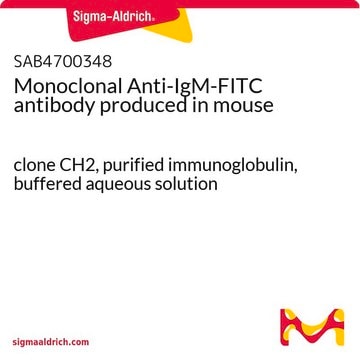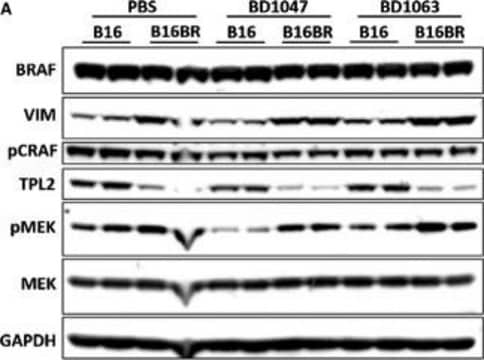SAB4700097
Monoclonal Anti-CD14 antibody produced in mouse
clone MEM-15, purified immunoglobulin, buffered aqueous solution
Sinónimos:
Anti-LPS-receptor
Iniciar sesiónpara Ver la Fijación de precios por contrato y de la organización
About This Item
UNSPSC Code:
12352203
NACRES:
NA.43
Productos recomendados
biological source
mouse
Quality Level
conjugate
unconjugated
antibody form
purified immunoglobulin
antibody product type
primary antibodies
clone
MEM-15, monoclonal
form
buffered aqueous solution
species reactivity
human, nonhuman primates
concentration
1 mg/mL
technique(s)
flow cytometry: suitable
isotype
IgG1
NCBI accession no.
UniProt accession no.
shipped in
wet ice
storage temp.
2-8°C
target post-translational modification
unmodified
Gene Information
human ... CD14(929)
General description
CD14 (cluster of differentiation 14) is a myelomonocytic differentiation antigen, encoded by the gene mapped to human chromosome 5q23-31. It is mainly expressed by monocytes, macrophages and activated granulocytes.
Immunogen
A crude mixture of human urinary proteins precipitated by ammonium sulphate from the urine of a patient suffering from proteinuria
Application
The reagent is designed for Flow Cytometry analysis. Suggested working dilution for Flow Cytometry is 4 μg/mL of sample. Indicated dilution is recommended starting point for use of this product. Working concentrations should be determined by the investigator.
Biochem/physiol Actions
CD14 (cluster of differentiation 14) serves as an important receptor of bacterial lipopolysaccharide (LPS). CD14 and LPs complex interacts with toll-like receptor 4 and enhances the expression of inflammatory mediators, including tumor necrosis factor (TNF)- and interleukin (IL)-1, via p38 mitogen-activated protein kinase and nuclear factor-B pathway. Mutation in the gene is associated with the development of myeloid leukemias and generalized chronic periodontitis (GCP).
Features and Benefits
Evaluate our antibodies with complete peace of mind. If the antibody does not perform in your application, we will issue a full credit or replacement antibody. Learn more.
Physical form
Solution in phosphate buffered saline, pH 7.4, with 15 mM sodium azide.
Disclaimer
Unless otherwise stated in our catalog or other company documentation accompanying the product(s), our products are intended for research use only and are not to be used for any other purpose, which includes but is not limited to, unauthorized commercial uses, in vitro diagnostic uses, ex vivo or in vivo therapeutic uses or any type of consumption or application to humans or animals.
¿No encuentra el producto adecuado?
Pruebe nuestro Herramienta de selección de productos.
Storage Class
10 - Combustible liquids
flash_point_f
Not applicable
flash_point_c
Not applicable
Elija entre una de las versiones más recientes:
¿Ya tiene este producto?
Encuentre la documentación para los productos que ha comprado recientemente en la Biblioteca de documentos.
Cytogenetic and molecular delineation of the smallest commonly
deleted region of chromosome 5 in malignant myeloid diseases
Le Beau MM
Proceedings of the National Academy of Sciences of the USA, 90, 5484-5488 (1993)
Synergistic contribution of CD14 and HLA loci
in the susceptibility to Buerger disease
Chen Z
Human Genetics, 122, 367-372 (2007)
The CD14 monocyte differentiation antigen maps to a region encoding growth factors and receptors.
Goyert SM
Science, 239, 497-500 (1988)
Dilshi Ishaan et al.
Genetic testing and molecular biomarkers, 21(9), 560-564 (2017-08-23)
The genetic variation in the CD14 rs2569190 promoter region contributes to the susceptibility of developing periodontitis. Since, CD14 gene polymorphism studies among various ethnic populations have produced conflicting results, the present study was designed to unearth the association between the
Nuestro equipo de científicos tiene experiencia en todas las áreas de investigación: Ciencias de la vida, Ciencia de los materiales, Síntesis química, Cromatografía, Analítica y muchas otras.
Póngase en contacto con el Servicio técnico








